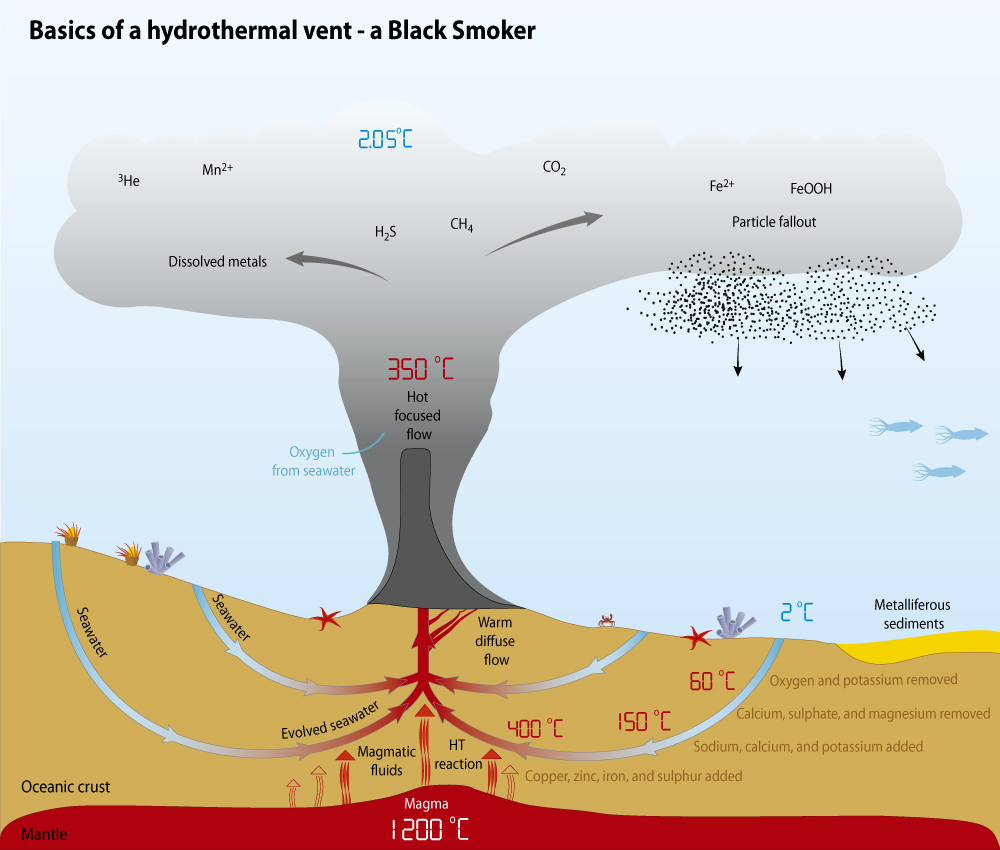The science behind the project
The Deep Sea, the biggest living system on Earth
The deep sea covers over half of the Earth’s surface area. With an average depth of almost 4000 meters, the deep ocean basins are the most poorly explored places on Earth. Characterized by the lack of light, high pressure, limited supply of nutrients, and temperatures ranging from 2°C to 100°C (in the seabed hot hydrothermal vents), it constitutes the life last frontier.
This biosphere represents the biggest living system on Earth, distinctive in its unparalleled complexity, although, massively integrated at all levels of ecological organisation.
It is estimated that the deep sea contains 80% of Earth’s biosphere and harbors between two million and twenty million unique species.
Deep-sea hydrothermal vents
Deep-sea hydrothermal vents are fissures or cracks in the ocean floor that emit hot, mineral-rich fluids. These vents are found in areas where tectonic plates meet and magma rises to the surface, heating the seawater that has seeped into the cracks. The hot fluids released by the vents can reach temperatures of up to 400 degrees Celsius and are rich in dissolved minerals, including sulfur, manganese, copper, and iron.

How Black Smokers are fomed?
Seawater percolates through the sea floor and is modified by chemical exchange with the surrounding rocks and rising magmatic fluid. The altered seawater is released back into the ocean at the vent site and forms a hydrothermal plume. The rising plume mixes rapidly with ambient seawater, lowering the temperature and diluting the particle concentration. The plume will continue to rise through seawater as long as it is less dense than the surrounding seawater. Once the density of the hydrothermal plume matches the density of the seawater, it stops rising and begins to disperse laterally. In a scenario like this, 90 per cent of the metals are lost to the plume and do not take part in the metal deposit formation process.
Image and the description credit: GRID-Arendal, https://www.grida.no/resources/8166
re-used with permission under the Creative Commons license: CC-BY-NC-SA 3.0
Deep-sea hydrothermal vents were first discovered in 1977. Watch the National Geograhic film https://education.nationalgeographic.org/resource/ocean-vent/ about this
the historical discovery and its significance to our understanding of life on Earth.
Deep-sea hydrothermal vents support unique ecosystems that are not dependent on sunlight for energy, unlike most other ecosystems on Earth. Instead, these ecosystems rely on chemosynthesis, a process by which microbes convert the minerals and gases released by the vents into organic matter that can be used as food by other organisms.
The INDEPTH Project expected outcomes
Harvesting from novel biodiversity from pristine Arctic hot vents
An innovative aspect of our project is the possibility to harvest from the microbial diversity in seabed hot vents located at the Arctic Mid-Ocean Ridge
(AMOR), inhabited by diverse novel and uncultured microorganisms.
The information of microbial composition and biogeochemical cycling of biogenic elements of such extreme ecosystems will help to understand the global change, threats, and opportunities posed by life in these settings.
Description – from Ida
New adaptive features in extremophiles
Bacteria and Archaea inhabiting Arctic deep-sea environments (including seafloor hot springs) developed a complex survival strategies that, in general, overlap evolutionary strategies of psychrophiles and thermophiles.
Within a single hydrothermal vent field, the physical and chemical conditions vary extensively, influencing biodiversity and adaptations, enabling us to study microorganisms living under the whole temperature range. The project will give an unique possibility to analyse various cooccurring survival strategies as we will study microbiocenoses created by polyextremophiles. Combining metagenomic analysis with gained information on yet unexplored deep-sea mobilomes will bring new insights on the role of mobile genetic elements in the adaptation of microbes to the particular ecological niche.
Novel enzymes
Today, the deep sea is also becoming a frontier for resource exploration and bioprospecting. It is clear that our future relies in many aspects of a sustainable use of marine resources and that the marine resources will become more and more important to support blue growth in Europe.
Extremophiles are source of invaluable enzymes that advanced our understanding of many biological phenomena and became indispensable tools for molecular biology and biotechnology.
We will focus on:
(i) proteins engaged in carbon biogeochemical cycling (proteases, chitinases, laccases);
(ii) lytic enzymes with antibacterial activity, which are perfectly suited as a scaffold for the development of novel antimicrobials
(iii) enzymes involved in the maintenance and multiplication of microbial genomes (DNA replication/transcription enzymes, DNA/RNA ligases, nucleases, SSB proteins, helicases, recombinases).
Key project outcomes:
1. Identification and characterization of metabolic pathways and enzymes (including novel ones) enabling microbes to thrive in deep-sea habitats.
2. Identification of various evolutionary strategies of polyextremophilic microbes.
3. Identification of novel mobile genetic elements and defining their role in adaptation of their extremophilic hosts.
4. Identification and complex characterization of molecules (enzymes, secondary metabolites) suitable for biotechnology.
5. Improved complementary collaboration between excellent Polish and Norwegian research environments
6. Training of Norwegian and Polish students and scientific staff in state-of-the-art metagenomics, bioinformatic and molecular methodologies